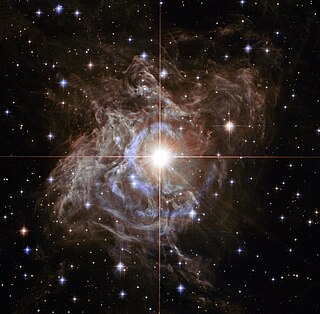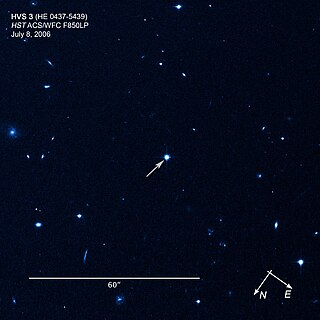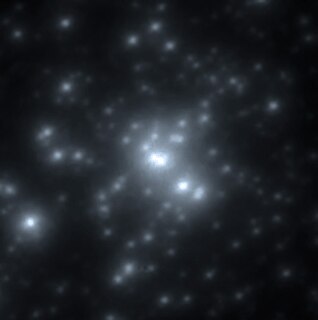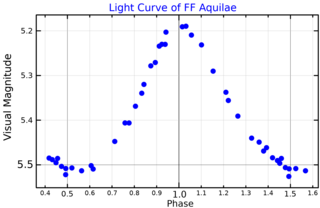
The Large Magellanic Cloud (LMC), or Nubecula Major is a satellite galaxy of the Milky Way. At a distance of around 50 kiloparsecs (≈160,000 light-years), the LMC is the second- or third-closest galaxy to the Milky Way, after the Sagittarius Dwarf Spheroidal (~16 kpc) and the possible dwarf irregular galaxy known as the Canis Major Overdensity. Based on readily visible stars and a mass of approximately 10 billion solar masses, the diameter of the LMC is about 14,000 light-years (4.3 kpc). It is roughly a hundredth as massive as the Milky Way and is the fourth-largest galaxy in the Local Group, after the Andromeda Galaxy (M31), the Milky Way and the Triangulum Galaxy (M33).

In astronomy, a semiregular variable star, a type of variable star, is a giant or supergiant of intermediate and late (cooler) spectral type showing considerable periodicity in its light changes, accompanied or sometimes interrupted by various irregularities. Periods lie in the range from 20 to more than 2000 days, while the shapes of the light curves may be rather different and variable with each cycle. The amplitudes may be from several hundredths to several magnitudes.

A Cepheid variable is a type of star that pulsates radially, varying in both diameter and temperature and producing changes in brightness with a well-defined stable period and amplitude.

The descriptive term long-period variable star refers to various groups of cool luminous pulsating variable stars. It is frequently abbreviated to LPV.
A Delta Scuti variable is a subclass of young pulsating star. These variables as well as classical cepheids are important standard candles and have been used to establish the distance to the Large Magellanic Cloud, globular clusters, open clusters, and the Galactic Center. The variables follow a period-luminosity relation in certain passbands like other standard candles such as Cepheids. SX Phoenicis variables are generally considered to be a subclass of Delta Scuti variables that contain old stars, and can be found in globular clusters. SX Phe variables also follow a period-luminosity relation. One last sub-class are the pre-main sequence (PMS) Delta Scuti variables.

HE 0437-5439 is a massive, unbound hypervelocity star (HVS), also called HVS3. It is a main sequence B-type star located in the Dorado constellation. It was discovered in 2005 with the Kueyen 8.2-metre (320 in) telescope, which is part of the European Southern Observatory's Very Large Telescope array. HE 0437-5439 is a young star, with an age of around 30 million years. The mass of the star is almost nine times greater than the mass of the Sun and the star is located 200,000 light years away in the direction of the Dorado constellation, 16 degrees northwest of the Large Magellanic Cloud (LMC) and farther away than the LMC. The star appears to be receding at an extremely high velocity of 723 kilometres per second (449 mi/s), or 2,600,000 kilometres per hour (1,600,000 mph). At this speed, the star is no longer gravitationally bound and will leave the Milky Way galaxy system and escape into intergalactic space. It was thought to have originated in the LMC and been ejected from it soon after birth. This could happen if it originally was one of a pair of stars and if there is a supermassive black hole in the LMC.

The Optical Gravitational Lensing Experiment (OGLE) is a Polish astronomical project based at the University of Warsaw that runs a long-term variability sky survey (1992–present). The main goals are the detection and classification of variable stars, discovery of microlensing events, dwarf novae, and studies of the structure of the Galaxy and the Magellanic Clouds. Since the project began in 1992, it has discovered a multitude of extrasolar planets, together with the first planet discovered using the transit method (OGLE-TR-56b) and gravitational microlensing. The project has been led by professor Andrzej Udalski since its inception.

W Mensae is an unusual yellow supergiant star in the Large Magellanic Cloud in the southern constellation Mensa. It is an R Coronae Borealis variable and periodically decreases in brightness by several magnitudes.

R136b is a Wolf–Rayet star in the R136 cluster in the Large Magellanic Cloud. It is one of the most massive and most luminous stars known. It is found in the dense R136 open cluster at the centre of NGC 2070 in the Tarantula Nebula.

FF Aquilae is a classical Cepheid variable star located in the constellation Aquila. It ranges from apparent magnitude 5.18 to 5.51 over a period of 4.470848 days, meaning it is faintly visible to the unaided eye in rural or suburban settings. Originally known as HR 7165, it was noted to be variable by Charles Morse Huffer in August 1927, who observed its Cepheid pattern. It then received the variable star designation FF Aquilae. Analysis of its brightness over 122 years shows that its period is increasing by 0.072 ± 0.011 seconds per year. It has been estimated to be 1,350 light-years ± 46 light-years distant from Earth.

Type II Cepheids are variable stars which pulsate with periods typically between 1 and 50 days. They are population II stars: old, typically metal-poor, low mass objects.

Classical Cepheids are a type of Cepheid variable star. They are population I variable stars that exhibit regular radial pulsations with periods of a few days to a few weeks and visual amplitudes from a few tenths of a magnitude to about 2 magnitudes.

Melnick 42 is a massive blue supergiant star in the Tarantula Nebula in the Large Magellanic Cloud located in the constellation Dorado. Although it is only 21 times the size of the sun, its high temperature of 47,300 K makes it one of the most luminous stars of the Tarantula Nebula at 3,600,000 L☉. It is less than two parsecs from the centre of the R136 cluster, although that is well outside the central core.

R136a2 is a Wolf-Rayet star residing near the center of the R136, the central concentration of stars of the large NGC 2070 open cluster in the Tarantula Nebula, a massive H II region in the Large Magellanic Cloud which is a nearby satellite galaxy of the Milky Way. It has one of the highest confirmed masses and luminosities of any known star, at about 187 M☉ and 5.6 million L☉ respectively.
HD 38282 is a massive spectroscopic binary star in the Tarantula Nebula, consisting of two hydrogen-rich Wolf-Rayet stars.
BL Herculis variables are a subclass of Type II Cepheids with low luminosity and mass, that have a period of less than eight days. They are pulsating stars making up a subclass of Type II Cepheids with light curves that frequently show a bump on the descending side for stars of the shortest periods and on the ascending side for longer period stars. Like other Type II Cepheids, they are very old population II stars found in the galaxy’s halo and globular clusters. Also, compared to other Type II Cepheids, BL Her variables have shorter periods and are fainter than W Virginis variables. Pulsating stars vary in spectral class as they vary in brightness and BL Herculis variables are normally class A at brightest and class F when most dim. When plotted on the Hertzsprung–Russell diagram they fall in-between W Virginis and RR Lyrae variables.
The Araucaria Project is an international science collaboration focused on improving the calibration of the extragalactic distance scale based on observations of major distance indicators in several nearby galaxies.

WR 20a is an eclipsing binary star belonging to or recently ejected from the young, massive cluster Westerlund 2. It was discovered in 2004 to be one of the most massive binary systems known, for which the masses of the components have been accurately measured.

R145 is a spectroscopic binary star in the Tarantula Nebula in the Large Magellanic Cloud located in the constellation Dorado. Both components are amongst the most luminous known.

In astronomy, a period-luminosity relation is a relationship linking the luminosity of pulsating variable stars with their pulsation period. The best-known relation is the direct proportionality law holding for Classical Cepheid variables, sometimes called the Leavitt law. Discovered in 1908 by Henrietta Swan Leavitt, the relation established Cepheids as foundational indicators of cosmic benchmarks for scaling galactic and extragalactic distances. The physical model explaining the Leavitt's law for classical cepheids is called kappa mechanism.














